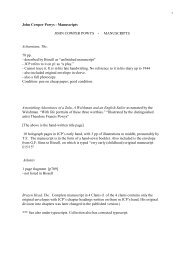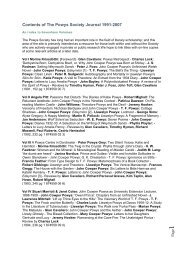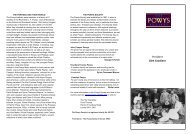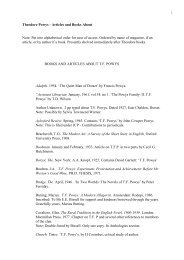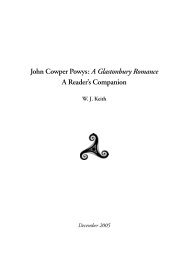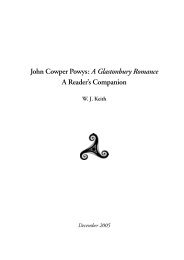J. C. Powys' Autobiography: A Reader's Companion - Site POWYS
J. C. Powys' Autobiography: A Reader's Companion - Site POWYS
J. C. Powys' Autobiography: A Reader's Companion - Site POWYS
Create successful ePaper yourself
Turn your PDF publications into a flip-book with our unique Google optimized e-Paper software.
46 <strong>Autobiography</strong><br />
exists (2003) in the garden of JCP’s house in<br />
Corwen.<br />
Peters, Rollo (595) — Charles Rollo Peters, an<br />
actor and “old friend of Marian Powys” (Letters to<br />
Miller [44]), mentioned in Letters to Llewelyn (I<br />
232, II 81), Llewelyn’s The Verdict of Bridlegoose<br />
(42), and from time to time in Jack and Frances (I).<br />
Petronius (476) — First-century writer, companion<br />
of Nero (q.v.), to whom is attributed the satirical<br />
romance known as the Satyricon.<br />
Petrushka (166, 198; cf.136) — A “half-doll halfhuman<br />
grotesque,” a character in a ballet by<br />
Stravinsky, and a name JCP applied to<br />
himself—hence the title of the selections from his<br />
diaries, Petrushka and the Dancer (see especially<br />
xxvi).<br />
Phædruses (166) — Phædrus was one of Socrates'<br />
disciples and the name-character in one of Plato’s<br />
Socratic dialogues.<br />
Pharaoh (324) — For Pharaoh and his “hard<br />
heart,” see Exodus 8: 19, 32.<br />
Pharisee (454) — A member of a group of<br />
influential Jews from the second century BC; in<br />
the first century AD looked upon by the writers of<br />
the Gospels, perhaps unfairly, as legalists and<br />
hypocrites (see Matthew 23). JCP seems to<br />
emphasize their preoccupation with personal<br />
ritual. The “Great Magician” was, of course, Jesus.<br />
So “Pharisaic” (454, 465) and “Pharisaism” (455).<br />
See also “I too ...”<br />
Phelips, Mr. W. R. (115) — Owner of Montacute<br />
House, who appointed the vicars of Montacute.<br />
See also under “Brympton House.”<br />
Phillips, Rachel (569) — A woman buried in “the<br />
tiny Second Cemetery of the Spanish and<br />
Portuguese Synagogue” on West 11 th Street<br />
(Gostick [36]), near JCP’s flat in Patchin Place,<br />
about whom he fantasized. Mentioned on several<br />
occasions in his diaries.<br />
“Philosophy of Representation” (361) — JCP is<br />
here referring to the philosophy he assigned to<br />
Richard Gaul in Weymouth Sands (99, 158).<br />
Phorkyads (626) — According to Robert Graves<br />
(228), these were the daughters of Phorcus, elder<br />
sisters of the Gorgons. They had one eye and one<br />
tooth between them, and in order to break their<br />
power Perseus, in his quest to slay Medusa, had<br />
to gain control of both.<br />
“physiognomic eye” (171) — A phrase from<br />
Spengler (q.v.), also quoted in The Art of Growing<br />
Old (76) and Rabelais (47, 286).<br />
Piazza del Spagna (295) — The location of the<br />
famous Spanish Steps in Rome.<br />
Piel, Paul (568–9) — Though I have consulted<br />
numerous reference books listing American<br />
sculptors, I have found no further information<br />
concerning Paul Piel.<br />
Pierrots (136) — White-faced male characters in<br />
French pantomime.<br />
Pilate (223, 428, 645–6) — Pontius Pilate, prefect of<br />
Judea at the time of the crucifixion of Jesus. For<br />
his washing of his hands (223, 645–6), see<br />
Matthew 27:24; for the question “What is Truth?”<br />
(428), see John 18:38, and compare the wellknown<br />
opening of Francis Bacon’s essay “On<br />
Truth”: “‘What is truth?’ said jesting Pilate, and<br />
did not stay for an answer.”<br />
pilgarlick (44) — A bald-headed old man. A<br />
favourite dialect word with JCP, who uses it, for<br />
instance, in A Glastonbury Romance (546, 585)<br />
and in Weymouth Sands (328). He probably<br />
derived it from Motteux’s completion of<br />
Urquhart’s translation of Rabelais (Book 5, ch.7).<br />
NB: It is usually spelt without the final “k.”<br />
pillar-boxes (429) — A British term for mail-boxes.<br />
Pincian Hill (296) — Another of the famous seven<br />
hills of Rome.<br />
“pinfold ... confined and pestered” (60) — From<br />
Milton’s Comus (l.7), also quoted in The Art of<br />
Happiness ([1935] 205).<br />
Pintoricchio (404) — In fact, Bernadine<br />
Pinturicchio (1454–1513), an Italian painter.<br />
Pirus Japonica (30) — (More usually “Pyrus”)<br />
Japanese Quince. For the last hundred years it<br />
has been the chief spring ornament of English<br />
gardens. Its blossoms, which vary in colour from<br />
creamy white to rich red, are produced during<br />
the winter and early spring months.<br />
Pistol (586) — The cowardly braggart in<br />
Shakespeare’s 2 Henry IV and Henry V.<br />
Plato (120, 135, 222, 286, 485, 626) — Greek<br />
philosopher (c.427–c.347 BC), who wrote<br />
dialogues containing the teachings of Socrates.<br />
So, “Platonic” (127, 173, 205, 237, 270, 472, 481, 505)<br />
and “Platonist” (470, 563).<br />
Plaudite et vale! (122) — See “Have I not played<br />
...”<br />
Plays of Massinger (123) — A collection of plays<br />
by Philip Massinger (1583–1640), best known for A<br />
New Way to Pay Old Debts (1625–1626).<br />
“Please make Mary Crow happy” (536) — But he<br />
doesn’t actually say “Please”! See A Glastonbury<br />
Romance (90) Llewelyn was unimpressed with<br />
this defence; see Letters of Llewelyn Powys (189).<br />
“Pleasure ... itself” (57) — See “the pleasure ...”<br />
Plotinus (285) — Greek philosopher (203–70),<br />
leader of the Neoplatonic school, best known for<br />
his Enneads.<br />
Pluto (227) — The Greek god of Hades, who<br />
carried off Proserpina (q.v.) to be his queen.




